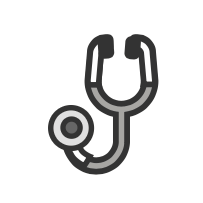DOCTOR INFORMATION
Abdominal Examination (OSCE)
Abdominal Examination
Introduction
- Greet the patient and introduce yourself

- Confirm patient details
- Briefly explain the examination in a patient friendly manner
- Get patient consent
- Set the head of the bed to a 45° angle 📐
- Wash hands ✋
- Expose patient’s abdomen and lower legs
- Check the patient is not in any pain
General inspection of the patient
Identify any clinically relevant signs:
 Age: e.g. IBD more common diagnosis in younger patient whereas malignancy and chronic liver disease is more common in older patients
Age: e.g. IBD more common diagnosis in younger patient whereas malignancy and chronic liver disease is more common in older patients
 Pain: examine the area where the pain is
Pain: examine the area where the pain is
 Confusion: end stage liver disease symptom
Confusion: end stage liver disease symptom
 Pallor: anaemia
Pallor: anaemia
 Jaundice: high bilirubin levels associated with liver pathology
Jaundice: high bilirubin levels associated with liver pathology
 Scars: prior surgery
Scars: prior surgery
 Hyperpigmentation: darkening of the skin due to haemochromatosis
Hyperpigmentation: darkening of the skin due to haemochromatosis
 Hernias: coughing can make them more visible
Hernias: coughing can make them more visible
 Oedema: swollen limbs or abdomen due to liver cirrhosis
Oedema: swollen limbs or abdomen due to liver cirrhosis
 Cachexia: muscle loss due to malignancy or advanced liver failure
Cachexia: muscle loss due to malignancy or advanced liver failure
Identify any objects or equipment that may be relevant:
 Prescriptions: recent medications 💊
Prescriptions: recent medications 💊
 Mobility aids ♿
Mobility aids ♿
 Feeding tubes
Feeding tubes
 Fluid balance: indicate fluid overload or dehydration
Fluid balance: indicate fluid overload or dehydration
 Vital signs: reflect past and present clinical status
Vital signs: reflect past and present clinical status
 Surgical drains: record the type and location
Surgical drains: record the type and location
 Stoma bag: record the location
Stoma bag: record the location
 Other medical equipment
Other medical equipment
Hands
Inspection of hands
Inspect the palms ✋:
 Pallor: anaemia
Pallor: anaemia
 Dupuytren’s contracture
Dupuytren’s contracture
 Palmar erythema: red palm of hand, can indicate liver disease
Palmar erythema: red palm of hand, can indicate liver disease
Inspect the nails ✋:
 Leukonychia: hypalbuminaemia can cause the nail bed to whiten
Leukonychia: hypalbuminaemia can cause the nail bed to whiten
 Koilonychia: anaemia can present with ‘spoon shaped’ nails
Koilonychia: anaemia can present with ‘spoon shaped’ nails
Assess for finger clubbing ✋:
- Ask the patient to put the nails of their index fingers back to back
- If you cannot see a diamond shaped window, the patient has ‘finger clubbing’
 The normal angle between the nail and the nail bed is lost due to soft tissue in the finger-tip swelling
The normal angle between the nail and the nail bed is lost due to soft tissue in the finger-tip swelling
 Can indicate: coeliac disease, IBD, lymphoma of the gastrointestinal tract and liver cirrhosis
Can indicate: coeliac disease, IBD, lymphoma of the gastrointestinal tract and liver cirrhosis
Assess for Asterixis ✋:
- Ask the patient to put both arms out in front of them, bending their hands backwards at the wrist joint and holding for 30 seconds
- Observe for hand ‘flapping’
 Asterixis, or ‘flapping tremor’ is identified by the hands flapping
Asterixis, or ‘flapping tremor’ is identified by the hands flapping
 Can indicate: hepatic encephalopathy, uraemia, or CO2 retention
Can indicate: hepatic encephalopathy, uraemia, or CO2 retention
Palpation of the hands
Assess the temperature:
 Symmetrical warmth indicates the patient is healthy
Symmetrical warmth indicates the patient is healthy
 Cold hands indicate poor peripheral perfusion ❄
Cold hands indicate poor peripheral perfusion ❄
Assess the radial pulse:
- Use your middle and index fingertips to palpate
- Assess the rate and rhythm
Assess for Dupuytren’s contracture:
- Palpate the palm
- Identify thickened, ‘cord-like’ bands of palmar fascia
 The thickening of the palmar fascia, producing ‘cords’ will cause finger and thumb deformities
The thickening of the palmar fascia, producing ‘cords’ will cause finger and thumb deformities
Arms and axillae
Inspect the arms:
 Needle track marks: indicative of intravenous drug use which can increase hepatitis risk
Needle track marks: indicative of intravenous drug use which can increase hepatitis risk
 Bruising: indicative of clotting abnormalities caused by liver disease
Bruising: indicative of clotting abnormalities caused by liver disease
 Excoriations: scratch marks which may indicate cholestasis
Excoriations: scratch marks which may indicate cholestasis
Inspect the axillae:
 Hair loss: due to iron deficiency anaemia or malnutrition
Hair loss: due to iron deficiency anaemia or malnutrition
 Acanthosis nigricans: thickened or darkened skin due to insulin resistance or gastrointestinal malignancy
Acanthosis nigricans: thickened or darkened skin due to insulin resistance or gastrointestinal malignancy
Face
Inspect the eyes:
 Jaundice: visible in the upper region of the sclera
Jaundice: visible in the upper region of the sclera
 Perilimbal injection: inflammation of the conjunctiva region adjacent to the iris, can be indicative of IBD
Perilimbal injection: inflammation of the conjunctiva region adjacent to the iris, can be indicative of IBD
 Corneal arcus: white/grey/blue ring in the peripheral cornea, in patients <50 indicates hypercholesterolaemia
Corneal arcus: white/grey/blue ring in the peripheral cornea, in patients <50 indicates hypercholesterolaemia
 Kayser-Fleischer rings
Kayser-Fleischer rings
 Conjunctival pallor: indicates anaemia
Conjunctival pallor: indicates anaemia
 Xanthelasma: raised, yellow, cholesterol rich deposits on the area around the eye which indicate hypercholesterolaemia
Xanthelasma: raised, yellow, cholesterol rich deposits on the area around the eye which indicate hypercholesterolaemia
Inspect the mouth:
 Oral candidiasis: fungal infection, identified by white mouth, caused by immunosuppression
Oral candidiasis: fungal infection, identified by white mouth, caused by immunosuppression
 Hyperpigmented macules: polyps in the gastrointestinal tract caused by the genetic, Peutz-Jeghers syndrome
Hyperpigmented macules: polyps in the gastrointestinal tract caused by the genetic, Peutz-Jeghers syndrome
 Glossitis: enlarged tongue 👅, caused a deficiency in B12, iron and folate
Glossitis: enlarged tongue 👅, caused a deficiency in B12, iron and folate
 Aphthous ulceration: round or ovular ulcers on the mucosal membranes, which can also indicate B12, iron and folate deficiency
Aphthous ulceration: round or ovular ulcers on the mucosal membranes, which can also indicate B12, iron and folate deficiency
 Angular stomatitis: inflammation of the corners of the mouth caused by a variety of things such as iron deficiency
Angular stomatitis: inflammation of the corners of the mouth caused by a variety of things such as iron deficiency
Neck
 Metastatic intrabdominal malignancy can be identified by a swollen Virchow’s node (left supraclavicular lymph node)
Metastatic intrabdominal malignancy can be identified by a swollen Virchow’s node (left supraclavicular lymph node)
 Oesophageal cancer can be identified when the right supraclavicular lymph node is swollen
Oesophageal cancer can be identified when the right supraclavicular lymph node is swollen
Palpate for lymphadenopathy:
 Palpate on both sides to identify swelling
Palpate on both sides to identify swelling
Chest
 Hair loss: can be caused by increased oestrogen or malnourishment
Hair loss: can be caused by increased oestrogen or malnourishment
 Spider naevi: lesions with a red centre and fine red lines extended from it ‘like a spider’, due to increased oestrogen levels, >5 indicate liver cirrhosis
Spider naevi: lesions with a red centre and fine red lines extended from it ‘like a spider’, due to increased oestrogen levels, >5 indicate liver cirrhosis
 Gynaecomastia: male breast tissue enlarges due to increased oestrogen or medication such as digoxin/ spironolactone
Gynaecomastia: male breast tissue enlarges due to increased oestrogen or medication such as digoxin/ spironolactone
Abdomen
 Hernias: assess for protrusions when coughing
Hernias: assess for protrusions when coughing
 Scars: indicate previous surgery
Scars: indicate previous surgery
 Striae: ‘stretch marks’ caused by rapid growth or skin stretching
Striae: ‘stretch marks’ caused by rapid growth or skin stretching
 Abdominal distension: caused by the 6F’s (foetus/faeces/fat/fluid/flatus)
Abdominal distension: caused by the 6F’s (foetus/faeces/fat/fluid/flatus)
 Cullen’s sign: bruising around the umbilicus indicates late stage pancreatitis
Cullen’s sign: bruising around the umbilicus indicates late stage pancreatitis
 Caput medusae: swollen paraumbilical veins and hypertension of the portal vein
Caput medusae: swollen paraumbilical veins and hypertension of the portal vein
 Grey-Turner’s sign: bruised flanks indicating haemorrhagic pancreatitis
Grey-Turner’s sign: bruised flanks indicating haemorrhagic pancreatitis
Assess any stomas present:
 Contents: stool/urine
Contents: stool/urine
 Spout: no spout in ileostomies/urostomies, spout present in colostomies
Spout: no spout in ileostomies/urostomies, spout present in colostomies
 Location: indicates type of stoma (right iliac fossa = ileostomies and urostomies, left iliac fossa = colostomies)
Location: indicates type of stoma (right iliac fossa = ileostomies and urostomies, left iliac fossa = colostomies)
Palpation of the abdomen
Prepare for palpation:
- Lay patient flat on bed
- Check for abdominal pain
- Identify pain by watching their face when palpating
Light palpation:
Assess for signs of pathology as you lightly palpate the 9 abdominal regions:
 Masses
Masses
 Tenderness
Tenderness
 Guarding: involuntary tensing
Guarding: involuntary tensing
 Rovsing’s sign: pain in right iliac fossa when palpating the left, can indicate peritonitis
Rovsing’s sign: pain in right iliac fossa when palpating the left, can indicate peritonitis
 Rebound tenderness: slow compression and quick release of the abdominal wall causes pain which can indicate peritonitis
Rebound tenderness: slow compression and quick release of the abdominal wall causes pain which can indicate peritonitis
Deep palpation:
Apply more pressure and assess for signs of pathology as you palpate the 9 abdominal regions:
 Mobility: distinguish between superficial masses and those attached to other structures
Mobility: distinguish between superficial masses and those attached to other structures
 Location: record which region the mass is present
Location: record which region the mass is present
 Pulsatility: pulsatile masses, associated with vascular origins
Pulsatility: pulsatile masses, associated with vascular origins
 Consistency: smooth/soft/hard etc.
Consistency: smooth/soft/hard etc.
 Size/shape: approximately measure the size of the mass
Size/shape: approximately measure the size of the mass
Liver palpation:
- Palpate the right iliac fossa as the patient inhales deeply to feel for the liver edge
- Repeat, moving 1 to 2 cm upwards each time until you reach the right costal margin
- If you identify the liver edge, record the following:
- Position: greater than 2cm beneath the costal margin indicates hepatomegaly
- Tenderness: can indicate hepatitis or cholecystitis
- Consistency: if the liver edge feels nodular, it can indicate cirrhosis
- Pulsatility: can indicate tricuspid regurgitation
Hepatomegaly causes:
 Hepatitis
Hepatitis
 Leukaemia
Leukaemia
 Haemolytic anaemia
Haemolytic anaemia
 Wilson’s disease
Wilson’s disease
 Glandular fever
Glandular fever
 Hepatocellular carcinoma
Hepatocellular carcinoma
 Primary biliary cirrhosis
Primary biliary cirrhosis
 Hepatic metastases
Hepatic metastases
 Haemochromatosis
Haemochromatosis
 Myeloma
Myeloma
 Tricuspid regurgitation
Tricuspid regurgitation
Gall bladder palpation:
 If you can palpate the gall bladder, it suggests it is enlarged due to biliary flow obstruction/infection
If you can palpate the gall bladder, it suggests it is enlarged due to biliary flow obstruction/infection
- Palpate at the right costal margin, in the mid-clavicular line
- If you identify a motile round mass, it suggests the gall bladder is enlarged
- Pain suggest cholecystitis (Murphy’s sign)
- Murphy’s sign is identified when you palpate the fall bladder as the patient inhales deeply and they suddenly stop mid-breath because they are in pain
- No pain suggests pancreatic cancer
Spleen palpation:
- Palpate the right iliac fossa as the patient inhales deeply to feel for the splenic edge
- Repeat, moving 1 to 2 cm towards the left costal margin
- If you identify the splenic edge, it is suggestive of splenomegaly
Splenomegaly causes:
 Glandular fever
Glandular fever
 Haemolytic anaemia
Haemolytic anaemia
 Portal hypertension caused by liver cirrhosis
Portal hypertension caused by liver cirrhosis
 Splenic metastases
Splenic metastases
 Congestive heart failure
Congestive heart failure
Kidney Balloting:
- Place your left hand ✋ under the back, standing on the opposite side
- Place your right hand ✋ just below the right costal margin
- Push your right hand ✋ down and your left up as the patient inhales deeply
- If you ballot the kidney, record its consistency and size
- Repeat for the left kidney
Enlarged kidney causes:
 Unilaterally enlarged: renal tumour
Unilaterally enlarged: renal tumour
 Bilaterally enlarged: polycystic kidney disease or amyloidosis
Bilaterally enlarged: polycystic kidney disease or amyloidosis
Aorta palpation:
- Palpate just above the umbilicus in the midline using both of your hands
- Record how your fingers move:
- Outwards: indicates expansile mass
- Superiorly: normal
 Further tests are require before diagnosis
Further tests are require before diagnosis
Bladder palpation:
- Ask the patient to use the toilet before beginning
- Palpate in the suprapubic area to identify if it is palpable and hence distended
Abdominal percussion

Liver percussion:
- Percuss the right iliac fossa
- Repeat, moving 1 to 2 cm towards the right costal margin until the percussion note becomes dull rather than resonant (indicates border of lower liver)
- Continue to percuss upwards, 1 to 2 cm at a time until the percussion notes changes from dull to resonant (indicates upper liver border)
- Approximate the size of the liver
Spleen percussion:
- Percuss the right iliac fossa
- Repeat, moving 1 to 2 cm towards the left costal margin, until the percussion note becomes resonant rather than dull (indicates location of spleen)
- If you identify the spleen it is suggestive of splenomegaly
Bladder percussion:
- Percuss in the midline of the umbilical region, moving downwards towards the pubic symphysis
- When the percussion note becomes dull, you have identified the upper border of the bladder
Shifting dullness:
- Percuss from the umbilical region, upwards towards the left flank
- A dull percussion note can indicate ascitic fluid in the flank
- Ask the patient to role onto their side for 30 seconds ⏱ (keep your fingers in the position where the note became dull)
- Repeat percussion, the percussion note should now be resonant to confirm ascites presence
Abdominal auscultation
Bowel sounds 👂:
Auscultate in ≥2 abdominal areas
 Normal bowel sounds: gurgling
Normal bowel sounds: gurgling
 Absent bowel sounds: suggestive of ileus (malfunctioning peristalsis disrupts the intestine functioning)
Absent bowel sounds: suggestive of ileus (malfunctioning peristalsis disrupts the intestine functioning)
 Tinkling bowel sounds: bowel obstruction
Tinkling bowel sounds: bowel obstruction
Bruit identification:
Identify vascular bruits (indicate turbulent blood flow) by auscultating over the aorta and renal arteries
 Aortic bruits: 1 to 2 cm above the umbilicus, can indicate abdominal aortic aneurysm
Aortic bruits: 1 to 2 cm above the umbilicus, can indicate abdominal aortic aneurysm
 Renal bruits: 1 to 2 cm above the umbilics, but slightly to the side of the midline on both sides, can indicate renal artery stenosis
Renal bruits: 1 to 2 cm above the umbilics, but slightly to the side of the midline on both sides, can indicate renal artery stenosis
Legs
 Identify pitting oedema on the lower legs, can indicate hypalbuminaemia
Identify pitting oedema on the lower legs, can indicate hypalbuminaemia
Completion
- Tell the patient the examination is complete, and thank them
- Wash hands ✋
- Summarise what the examination revealed
Summary:
- Greet the patient and briefly explain the examination
- Inspect the patient to identify any clinically relevant signs
- Inspect the patient's arms, axillae, face and mouth
- Palpate the neck for lymphadenopathy
- Inspect the chest and abdomen for any clinical features
- Assess any stomas present
- Palpate, percuss and auscultate the abdomen
- Assess for pitting oedema on the lower legs
- Complete the examination by thanking the patient
Related Articles
This step by step guide is designed to take you through the hernia examination in OSCEs.














